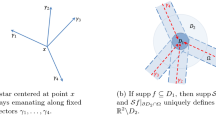Abstract
In certain real-world applications, one needs to estimate the angular frequency of a spinning object. We consider the image processing problem of estimating this rate of rotation from a video of the object taken by a camera aligned with the axis of rotation. For many types of spinning objects, this problem can be addressed with existing techniques: simply register two consecutive video frames. We focus, however, on objects whose shape and intensity changes greatly from frame to frame, such as spinning plumes of plasma that emerge from a certain type of spacecraft thruster. To estimate the angular frequency of such objects, we introduce the Geometric Sum Transform (GST), a new rotation-based generalization of the discrete Fourier transform (DFT). Taking the GST of a given video produces a new sequence of images, the most coherent of which corresponds to the object’s true rate of rotation. After formally demonstrating this fact, we provide a fast algorithm for computing the GST which generalizes the decimation-in-frequency approach for performing a Fast Fourier Transform (FFT). We further show that computing a GST is, in fact, mathematically equivalent to computing a system of DFTs, provided one can decompose each video frame in terms of an eigenbasis of a rotation operator. We conclude with numerical experimentation.
Similar content being viewed by others
References
Bluestein, L.I.: A linear filtering approach to the computation of the discrete Fourier transform. Northeast Electron. Res. Eng. Meet. Rec 10, 218–219 (1968)
Brigham, E.O.: The fast Fourier transform and its applications. Prentice-Hall, Upper Saddle River (1988)
Cooley, J.W., Tukey, J.W.: An algorithm for the machine calculation of complex Fourier series. Math. Comput. 19, 297–301 (1965)
Fickus, M., Mixon, D.G.: Isotropic moments over integers lattices. Appl. Comput. Harmon. Anal. 26, 77–96 (2009)
Liu, D.: Two-dimensional time-dependent plasma structures of a Hall effect thruster, Ph.D. Thesis, Air Force Institute of Technology (2011)
Heideman, M.T., Johnson, D.H., Burrus, C.S.: Gauss and the history of the fast Fourier transform. IEEE ASSP Mag. 1, 14–21 (1984)
McDonald, M.S., Bellant, C.K., St. Pierre, B.A., Gallimore, A.D.: Measurement of cross-field electron current in a Hall thruster due to rotating spoke instabilities, 47th AIAA/ASME/SAE/ASEE, Jt. Propuls. Conf., AIAA, 2011-5810/1–22 (2011)
Smith, L.N.: Determining angular frequency from video with a generalized fast Fourier transform. M.S. Thesis, Air Force Institute of Technology (2012)
Author information
Authors and Affiliations
Corresponding author
Additional information
Communicated by: Zydrunas Gimbutas
Rights and permissions
About this article
Cite this article
Smith, L.N., Fickus, M. Determining angular frequency from images of rotating objects via a generalized fast Fourier transform. Adv Comput Math 40, 27–47 (2014). https://doi.org/10.1007/s10444-013-9296-1
Received:
Accepted:
Published:
Issue Date:
DOI: https://doi.org/10.1007/s10444-013-9296-1




